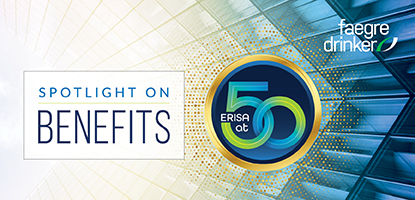Congress included “SECURE 2.0 of 2022” in the Consolidated Appropriations Act, 2023, the $1.7-trillion omnibus spending bill, which was signed by President Biden on December 29, 2022 (the date of enactment). Secure 2.0 is a follow-up to the Setting Every Community Up for Retirement Enhancement Act passed in 2019, now known as “SECURE 1.0.”
Below is a brief rundown of some of the highlights in SECURE Act 2.0 of 2022 for defined contribution plan sponsors:
- Required Minimum Distribution Age Increase: SECURE Act 1.0 increased the age at which required minimum distributions (RMDs) must begin from 70.5 to 72 beginning in 2020. SECURE Act 2.0 increases the RMD age to 73 beginning January 1, 2023, and then to age 75 beginning January 1, 2033.
- No More Roth RMDs. Beginning January 1, 2024, the required minimum distribution rules for defined contribution plans no longer apply to Roth accounts. This rule will not apply to the RMD distribution for 2023 that must be paid by April 1, 2024, for individuals who reach the RMD age in 2023.
- Increased Catch-Up Contributions for Ages 60-63: Beginning in 2025, the contribution limit for catch-up contributions for individuals ages 60-63 will be the greater of (a) $10,000 (indexed for inflation) or (b) 150 percent of the regular catch-up contribution limit.
- Catch-Up Contributions as Roth Only: Effective January 1, 2024, catch-up contributions will be Roth only for employees whose compensation was greater than $145,000 (indexed for inflation) in the prior calendar year. Plans that allow only pre-tax contributions must be amended to allow Roth catch-up contributions as well.
- Matching Contributions and Nonelective Contributions as Roth: Effective immediately, plan sponsors can offer employees the choice to have employer matching contributions and nonelective contributions made on a Roth basis.
- Student Loan Matching Contributions: Beginning January 1, 2024, plans are allowed to treat student loan payments as elective deferrals for purposes of providing an employer matching contribution under Code § 401(m). Plans may also test the individuals receiving student loan matching contributions separately for purposes of the actual deferral percentage (ADP) test. Solely for purposes of satisfying a 401(k) Safe Harbor, student loan payments may be treated as elective deferrals.
- New Plans ‑ Mandatory Automatic Enrollment and Automatic Increase: Applies, effective for plan years beginning on or after January 1, 2025, only to new defined contribution plans (including both 401(k) and 403(b) plans) established on or after December 29, 2022 (the date of enactment), with additional exceptions for church plans, governmental plans, and plans of employers with 10 or fewer employees or new businesses that have been in existence for less than three years. SECURE 2.0 requires new plans to automatically enroll participants between three-10 percent of compensation and automatically increase their contributions by one percent until reaching at least 10 percent and not more than 15 percent of compensation.
- Speed up Participation of Long-Time Part-Time Workers in 401(k) Plans: SECURE Act 1.0 implemented a requirement that long-term part-time workers (anyone who worked 500 or more hours in the last three plan years, beginning with plan year 2021) be allowed to participate in the employer’s 401(k) plan. SECURE Act 2.0 shortens the required period to only two years working 500 or more hours beginning January 1, 2025.
- Easier Plan Administration: SECURE Act 2.0 contains a number of provisions designed to ease administration of defined contribution plans. A few examples include: changes to benefit overpayment recovery requirements; reduction in excise taxes for failure to make RMDs from 50 percent to 25 percent (with further reduction if corrected in certain timeframes); directing the DOL and Treasury to issue guidance on consolidating notices into one notice; and expansion of self-correction methods under the IRS Employee Plans Compliance Resolution System (EPCRS).
- Creation of Retirement Savings Lost and Found: Within 2 years of the date of enactment, the Department of Labor (in consultation with the Treasury Department) will establish a searchable database for lost participant benefits.
- Increased Small Benefit Cash-out. For terminated employees, the mandatory cash-out limit is increased from $5,000 to $7,000, effective January 1, 2024.
- Small Financial Incentives to Contribute to 401(k) Plan. Plan sponsors may offer small de minimis financial incentives, like low-dollar gift cards, to employees who enroll in the company 401(k) or 403(b) Plan.
- Incentivizing Auto-Portability. Secure 2.0 allows plan sponsors to automatically transfer terminated employee accounts to their new employer’s account, subject to notice and dollar amount limitations.
- Qualified Birth or Adoption Recontribution Limited to 3 Years. SECURE 1.0 allowed qualified birth or adoption distributions to be repaid to the plan by the recipient at any time. SECURE 2.0 limits the recontribution period to 3 years from the date of the qualified birth or adoption distribution.
- Domestic Abuse Distributions. Effective January 1, 2024, plans may permit distributions to survivors of domestic abuse in an amount equal to the lesser of $10,000 or 50 percent of the account. These distributions are not subject to the 10 percent early withdrawal tax and may be repaid over a three-year period.
The above points are just a few of the items in SECURE Act 2.0 and we will continue to publish more detailed alerts on specific topics. If you have any questions, please reach out to your Faegre Drinker benefits counsel.
The material contained in this communication is informational, general in nature and does not constitute legal advice. The material contained in this communication should not be relied upon or used without consulting a lawyer to consider your specific circumstances. This communication was published on the date specified and may not include any changes in the topics, laws, rules or regulations covered. Receipt of this communication does not establish an attorney-client relationship. In some jurisdictions, this communication may be considered attorney advertising.

